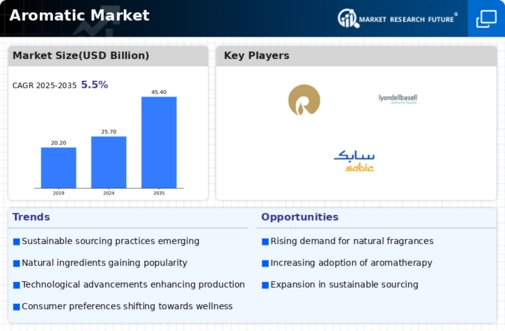Top Industry Leaders in the Aromatics Market

Aromatic Market
Aromatics, a diverse group of organic compounds with distinctive smells, are not just pleasant fragrances; they are crucial building blocks for countless industrial applications. From plastics and pharmaceuticals to paints and textiles, aromatics like benzene, toluene, xylene, and styrene underpin the modern economy. Navigating this dynamic space requires understanding the strategies, factors, and recent developments shaping the aromatic landscape.
Strategies for Capturing a Bigger Share of the Aromatic Bouquet:
-
Technological Innovation: Companies like ExxonMobil and Chevron are investing in cleaner production technologies like catalytic dehydrogenation and biomass-based feedstocks, aiming to reduce environmental impact and comply with stricter regulations. -
Feedstock Diversification: Moving beyond traditional petroleum-based feedstocks and exploring renewable sources like biomass and waste plastics offers a sustainable edge and reduces dependence on fossil fuels. -
Vertical Integration: Expanding beyond aromatic production into downstream industries like polystyrene and polyester creation strengthens market control and maximizes profits. -
Strategic Partnerships and Collaborations: Teaming up with research institutions, waste management companies, and renewable energy providers accelerates innovation, unlocks new resources, and promotes sustainable practices.
Factors Shaping Market Share Distribution:
-
Production Capacity and Efficiency: Companies with larger and more efficient facilities have a cost advantage and can cater to large-volume orders, attracting major manufacturers. -
Geographical Presence: Access to abundant and affordable feedstock, coupled with strong regional demand, gives companies like Sinopec and PetroChina an edge in Asia. -
Regulatory Compliance: Stringent environmental regulations in Europe and North America favor companies with cleaner production processes and waste management solutions. -
Product Quality and Consistency: Consistent production of high-purity aromatics with precise specifications is crucial for maintaining customer trust and securing long-term contracts.
Key Players:
- Canada Colors and Chemicals Limited
- BP PLC
- Dow
- Reliance Industries Ltd.
- LyondellBasell
- Shell Chemicals
- SABIC
- Exxon Mobil Corporation
Recent Developments (6 Months):
July 2023: The European Union proposes stricter regulations on aromatic emissions from industrial processes, prompting companies to invest in cleaner technologies.
August 2023: The Indian government announces a subsidy program for adopting cleaner aromatic production technologies, boosting the market for sustainable solutions.
September 2023: A research collaboration between universities and industry players makes significant progress in developing a commercially viable bio-based aromatic production process.
November 2023: The global aromatic market experiences a slight decline in demand due to economic slowdown in major consumer markets, particularly in construction and automotive sectors.

